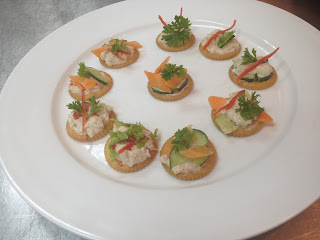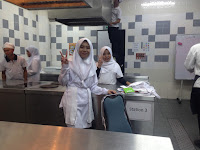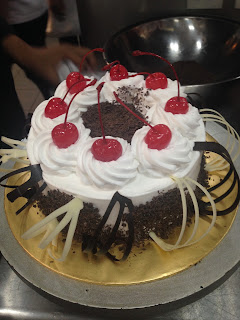CHAPTER 6 - EQUIPMENT, UTENSILS AND FACILITIES
CHAPTER 6 – FACILITIES,
EQUIPMENT AND UTENSILS
1.
DESIGN AND
MATERIAL
·
Cost
Ø
Some
of the major costs associated with the purchase of equipment are the purchase
price, installation cost, operating costs, maintenance costs and finance
charges.
Ø
Comparing
costs for different pieces of equipment that you are considering to purchase.
·
Size
& Design
Ø
Equipment
should easy fit into the space available in the layout of the facility.
Ø
Oversized
equipment can cause as much wasted effort as equipment that is too small.
Ø
Equipment
that sits on the floor and is not easily movable must be elevated on legs or
sealed to the floor.
Ø
Should
provide a minimum clearance of 6 inches (15 cm) between floor and bottom
surfaces
2.
DESIGN AND
FABRICATION
·
Food
equipment and utensils have food-contact and non food-contact surfaces.
·
Non
food-contact surfaces are the remaining standards from NSF International and
Underwriters Laboratories Inc. requires food equipment and utensils to be:
ü
Smooth
ü
Seamless
ü
Easily
cleanable
ü
Easy
to take part
ü
Easy
to reassemble
ü
Equipped
with rounded corners and edges
·
Metals
Ä
We
depend on metal for nearly everything in a food establishment.
Ä
Chromium over steel gives an easily
cleanable, high luster finish. It used for appliances such as toasters, waffles
irons and trim where high luster is desired.
Ä
Non
corrosive metal form by the alloys of iron, nickels and chromium may
also used in the construction of foodservice equipment.
Ä
AVOID: Lead, brass, cadmium and galvanized metal.
Its can cause chemical poisoning if contact with high acid foods.
·
Stainless
Steel
Ø
Its
one of the most popular materials for food operations.
Ø
Used
for food containers, table tops, sinks, dish tables, dishwashers and
ventilation hood systems.
Ø
Easier
to clean and maintain
·
Plastic
ü
Plastic
and fiberglass are frequently used in foodservice equipment because they are durable,
inexpensive and can be molded into different combinations.
ü
Examples:
o
Acrylics (used to make covers of food
containers)
o
Melamines (used for variety of dishes &
glassware)
o
Fiberglass (used in boxes, bus trays and
trays)
o
Nylon ( moving parts)
o
Polyethylene (storage with moving parts)
o
Polypropylene (dishwashing racks)
·
Wood
Ä
Light
and economical.
Ä
Disadvantages:
problem with sanitation, porous to bacteria and moisture, absorb food odors and
stains
Ä
FDA
Food Code permits the use of hard maple or an equally hard, close grained wood
for cutting boards, bakers table and paddles
Large
equipment
v The types and quantities of food to
be prepared in a food operation are prime considerations in selecting cooking
equipment.
v The frame, door, exterior and
interior materials should not take away from the durability and ability to
clean the unit as a whole.
v Only buy equipment approved by such
organizations as the American Gas Association, Underwriters Laboratories
(UL) and NSF International.
Ovens
v Heat in oven distributed by
radiation, conduction or convection, depending on the type of oven being used.
v Should be cool quickly when a drop
temperature is required.
v Range oven commonly used in small food
operations. It must have a good insulation and construction to prevent heat
loss.
Steam-
Jacketed kettles
v Consist of 2 bowl-like sections of
welded aluminium of stainless steel with an air space between for circulation
of steam.
v When the steam is released inside
the jacket, it condenses on the outside of the inner shell, thereby giving up
its heat to the metal, from which it is then transferred to food.
v May be stationery or tilting.
v Maximum load to fill the kettle
about 2/3 to ¾ full.
Refrigerators
and Freezers
v The efficient operation of a
refrigeration unit depends on several factors including: DESIGN,
CONSTRUCTION & CAPACITY OF EQUIPMENT
v Proper air circulation both inside
and outside the cabinet is important. The storage of food in shallow
containers, placed on slatted shelves or tray slides to permit food circulation
of the chilled air, is essential for both short and long term storage.
Reach in
Refrigeration
v Several types : pass through,
upright, under the counter, display cabinets, mobile or portable and dispensing
units
v Keep the doors to these
refrigerators closed tight, except when food is being put into or taken out the
unit.
Utensils
for preparing and serving food
v Single service articles include
tableware, carryout utensils and other items such as bags, containers,
stirrers, straw and wrappers that are designed and constructed to be used only
1 time by only 1 person.
v Single-use articles include items such
as wax paper, butcher paper, plastic wrap and certain type of food containers
that are designed to be used once and discarded.



Comments
Post a Comment